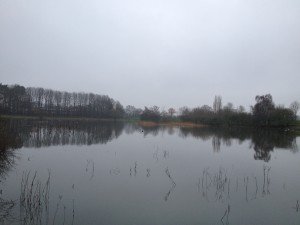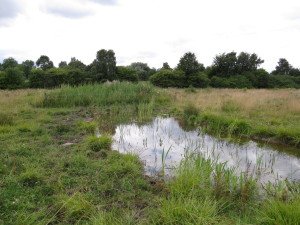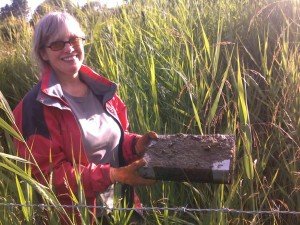Flagship Focus: Rawcliffe Meadows 2016
28th January 2016
Every month we are featuring one the many wonderful pond sites supported by our Flagship Pond project. Thanks to a grant from the Heritage Lottery Fund, we are able to help the people caring for some of the best pond sites in the country, making sure their special plants and animals have a secure future.
This month, Anne, People, Ponds & Water Project Officer for Northern England, introduces a special site in York.
 The Rawcliffe Flood basin in flood, December 2015
The Rawcliffe Flood basin in flood, December 2015
Rawcliffe Meadows, along with the Clifton and Rawcliffe Ings, is part of the Ouse Ings floodplain to the north of the City of York. The Flood Basin at Rawcliffe Meadows is a two hectare man-made wetland, created about 35 years ago when local flood defences were upgraded. The basin provided spoil for construction of the adjoining barrier bank, exposing the underlying laminated glacial clay. This is an ideal substrate for pond creation, and Friends of Rawcliffe Meadows, who have managed the site for over 25 years oversaw the excavation of over 15 ponds in the basin since the early 1990s. The site was chosen as a Flagship Pond site because of its diverse community of plants, animals and invertebrates, including uncommon and interesting species such as Tubular Water-dropwort, Bladder Sedge, Pink Water-speedwell Weevil and Water Vole.
 The first step to helping Friends of Rawcliffe Meadows safeguard this gem of a wildlife site was to commission freshwater ecologist, and longstanding Rawcliffe Meadows pond champion, Martin Hammond, to conduct an in-depth ecological survey of the ponds in the Basin. In 2015, Martin found that many of the ponds supported a diverse community of plants and invertebrates and the survey helped to pinpoint ponds that required management. He also found, excitingly, signs of Water Vole, one of the UK’s fastest declining mammals.
The first step to helping Friends of Rawcliffe Meadows safeguard this gem of a wildlife site was to commission freshwater ecologist, and longstanding Rawcliffe Meadows pond champion, Martin Hammond, to conduct an in-depth ecological survey of the ponds in the Basin. In 2015, Martin found that many of the ponds supported a diverse community of plants and invertebrates and the survey helped to pinpoint ponds that required management. He also found, excitingly, signs of Water Vole, one of the UK’s fastest declining mammals.
 Ann Hanson from Yorkshire Mammal Group found a raft covered in a Water Vole latrine
Ann Hanson from Yorkshire Mammal Group found a raft covered in a Water Vole latrine
To learn more about the Water Vole population, Ann Hanson of the Yorkshire Mammal Group was called in to carry out a more detailed survey. Ann and I also pegged out a number of small wooden Water Vole rafts along the ditches and in a couple of the ponds. It was hoped the voles would leave droppings or distinctive feeding remains on the rafts – finding these field signs in amongst dense vegetation would be unlikely. After a summer of monitoring the rafts, with very little evidence found, Ann was astonished to find in late July a massive latrine and droppings on the one of the rafts situated in a reed-filled pond.
 In order to further protect and expand this Water Vole habitat we commissioned a digger driver to expand the scrape adjacent to the pond in early November 2015. As the Water Voles in the well-established reed bed next door are unlikely to breed in the cattle-trampled edges of its newer neighbour, the next step will be to fence off this area, allowing tall, reedy vegetation to develop and for the voles to excavate burrows in peace. This will also benefit other species of conservation concern such as Reed Bunting. This work will hopefully be carried out in early 2016 once the current flooding has subsided.
In order to further protect and expand this Water Vole habitat we commissioned a digger driver to expand the scrape adjacent to the pond in early November 2015. As the Water Voles in the well-established reed bed next door are unlikely to breed in the cattle-trampled edges of its newer neighbour, the next step will be to fence off this area, allowing tall, reedy vegetation to develop and for the voles to excavate burrows in peace. This will also benefit other species of conservation concern such as Reed Bunting. This work will hopefully be carried out in early 2016 once the current flooding has subsided.
 Martin Hammond, Anne Heathcote and Mick Phythian by the newly extended pond
Martin Hammond, Anne Heathcote and Mick Phythian by the newly extended pond
Alongside the work to benefit Water Voles, one of the ponds identified by Martin as being of poor ecological value was excavated to provide extra habitat for the rare Tubular Water-dropwort. This pond is currently doing well and a volunteer is now in place to monitor the Tubular Water-dropwort population in the long term.
Want to know more?
- Read more about the Flagship Ponds project
- Learn about other parts of our People, Ponds & Water project, and how you can get involved
- Find out how your support can make a difference for freshwater wildlife
- Join the mailing list to get articles like this, and more, direct to your inbox
